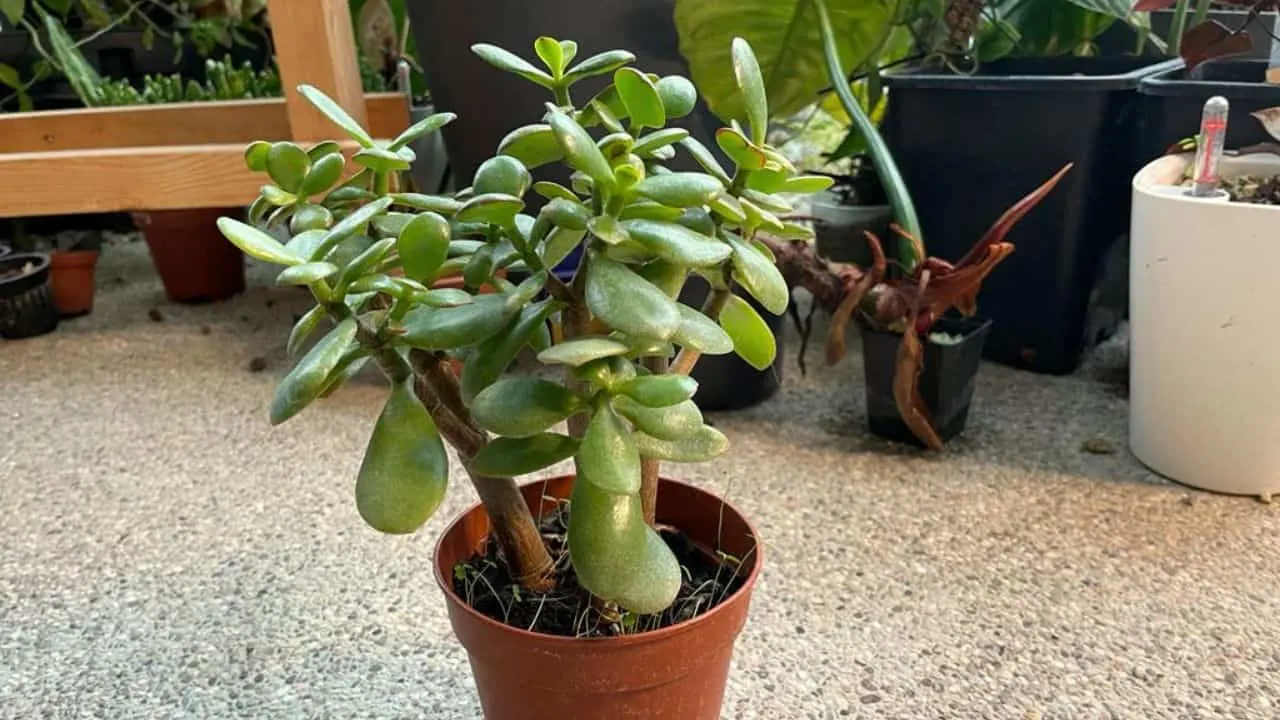Jade plants are both beautiful and easy to grow.
However, while caring for a Jade plant is generally pretty straightforward, ensuring that it has a full, bushy appearance can be quite a challenge.
Read on to learn how to achieve that lush, bushy look for your cherished “Lucky plant.”
Table of Contents
How to Make a Jade Plant Bushy
To make your Jade plant bushy, prune it regularly to evenly distribute growth and help support its weight. Use clean shears and trim no more than 25% of the plant back when pruning. Place Jade plants in direct, full sun for a bushy, full plant, too.
Tips for Pruning a Jade Plant
Pruning a Jade plant is the only way to keep it from leaning or bending over as it becomes taller and bigger.
So, if you ask yourself, “Why is my Jade plant leaning?” the obvious answer is because you did not prune it (well enough).
Plan on pruning your Jade at least once a year, but also as you assess the need periodically.
Some tips for pruning your Jade include the following:
- Start pruning your Jade when it is very young with very few leaves for the bushiest plant.
- Make sure to clean and sterilize your shears, scissors, or knives.
- Keep your pruning tools sharp for best results.
- Plan on pruning your Jade plant each spring just before the peak growth season for this plant.
- Consider giving your Jade a bit more sun during the summer months to promote bushy growth by taking it outside for natural sunlight. Bring it in before evening temps drop!
Be careful not to remove more than 25% of your plant during pruning, as this could compromise its well-being and hardiness.
A bushier look for smaller Jade plants (Crassula ovata)

For a bushier look, make sure to prune your Jade plant regularly!
For a small Jade plant six inches tall or shorter, prune by topping off the top or trunk of your plant. Remember that in every spot that you cut, two branches will start.
It is prudent to plan on pruning at least once a year, starting when the plant is young and small. Routine pruning will help make a bushier, more sturdy Crassula ovata.
Pruning Longer Branches
If your plant is tall or has long branches, plan on pruning and cutting the top fourth of the plant down.
Cut along the ring-shaped indentations on your mature Jade trunk and use this as a guide to prune.
Always use clean, sharp scissors or shears for the job.
By removing leaves from the main trunk, you will also be encouraging new growth and more limbs.
Pruning Larger Jade Plants
If you have a larger Jade plant or tree, trim any new growth that usually crops up at the end of the limbs and branches. This will cause new branches to sprout from where you cut.
When Jades get big, their tops become heavy, and it may be challenging for the plant to support its weight.
By pruning, you create a fuller plant that is more able to support the plant.
Caring for a Jade Plant
Jades thrive and do well indoors without a lot of special care. Plant Jades in containers with sandy, loamy soil for best results, and ensure it drains well.
If you position your plant in direct sun, the Jade will grow bushier and fuller.
Avoid watering overhead when caring for your Jade plant; water to the soil instead. Also, don’t keep the Jade plant moist. Allow this succulent plant to become dry before watering.
Also, do not regularly fertilize your Jade.
Since Jade plants are native to areas with soil that is rocky and not very nutrient-rich, you can kill this particular plant by feeding it too often.
Make sure to keep your Jade safe from drafts, such as near windows in winter.
Propagating a Jade Plant
After you have pruned your Jade plant, use the clippings and leaves to propagate new Jade plants!
Ensure you only use healthy clippings from your Jade- diseased or damaged leaves and stems should be discarded after pruning.
Stick the leave or stem, cut side down, in a container of sandy soil to propagate. Water occasionally, but do not let your Jade Plant soak in water, or it will rot.
Frequently Asked Questions
How can you propagate a Jade plant?
Take a single leaf or healthy stem from your Jade and propagate it directly in damp- but not wet- soil. Make sure to provide plenty of ventilation for the donor Jade plant so that the cut end can dry, heal, and recover quickly.
What soil type do Jade plants like best?
Jade plants do best in sandy, loamy soil that has good drainage. Since Jade plants are South African natives, they thrive in sandy, rocky soil.
Should you fertilize your Jade plant?
Jade plants do best if you do not fertilize them often. Dilute regular houseplant or succulent fertilizer and feed sparingly on rare occasions.
Are Jade plants toxic?
Jade plants may be toxic if consumed by humans or pets. Some possible side effects of ingesting a Jade plant include gastric issues, heartbeat irregularity, convulsions, and mood disorder.
Do pests bother Jade plants?
Jade plants may be vulnerable to spider mites or mealybugs but typically, pests are not a problem with healthy, thriving Jades.

Daniel has been a plant enthusiast for over 20 years. He owns hundreds of houseplants and prepares for the chili growing seasons yearly with great anticipation. His favorite plants are plant species in the Araceae family, such as Monstera, Philodendron, and Anthurium. He also loves gardening and is growing hot peppers, tomatoes, and many more vegetables.


